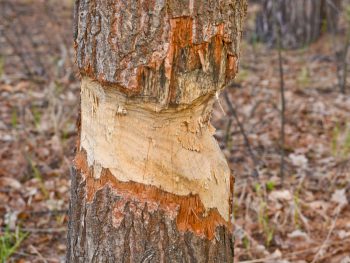
Even though you might love your pine tree to death (literally), you know that it is, in fact, dying, and that you will need to get rid of it somehow, especially since it has the potential to affect the other trees, plants, and flowers surrounding it. That said, you might be at loss for how to get started.
While you might feel stuck in this awkward limbo of whether or not to cut the tree down, let alone how to get started doing so, there is no need to fear: we are here to help! Read on to learn more in this article on how to kill a pine tree safely.
We will give you advice on the necessary tools and steps to take for the optimal procedure and soon enough, you can clear up your landscape in no time.
Without further ado, let’s get started!
Items You Will Need to Kill a Pine Tree
Granted, killing a pine tree can be a daunting task, especially when it comes to something so large and hefty to take on. While it might be intimidating at first, there is no need to be afraid.
By looking into and researching ahead just what items you will need to do so, you can have more confidence in making it a reality. With that said, here are just a few items you will need to kill a pine tree:
A Drill
It is a common tactic to use a drill to drill holes around the roots of the pine tree, as means of damaging the roots and preventing them from getting the nutrients that they need to continue growing. As a result, the holes slowly kill them off.
Chemicals
From herbicides to nitrogen fertilizer, there is a plethora of different chemicals that can be used to kill off a pine tree. Here, we list a few of the commonplace ones:
1. Glysophate
This chemical is the principle product in Roundup, and it serves as a notable product for pine tree control. It kills off pine trees by entering the plant through its foliar structure, i.e. penetrating the needles before killing it off.
However, the process is slow and it requires precise drilling and applying in order for the pine tree to weaken and eventually die.
2. Imazapyr
With this particular chemical, you can either use it alone or in conjunction with glysophate to kill pine trees, should you so desire.
It does so by removing the taller pines to let in more light, with which the heat can be used to kill off the roots, aside from avoiding watering and other essential strategies to keep a plant alive.
3. Metsulfuron
As an active ingredient in some leading herbicide brands like Escort and Matrix, metsulfuron is sure to kill off your pine tree in no time.
It has very similar chemical properties such as that of glysophate, but it works faster to kill the pine tree; as long as there are a few holes drilled into the plant, using metsulfuron should get rid of the tree in no time.
4. Nitrogen Fertilizer
Although appropriate for killing a pine tree, using nitrogen fertilizer will take a while to take effect, since its chemical properties are not as potent as the other chemicals described.
It requires that you drill several holes in the trunk area before applying the nitrogen fertilizer; soon enough, it will create fungi that will slowly eat away at the tree, eventually killing it.
5. 2,4-D
You can choose to use this chemical either as a spray, a cut method, or an injection. It is used to thin out pine stands and when used in conjunction with tichlophyr, it can certainly do the trick with effectively eliminating your pine tree.
A Saw
If you prefer to kill your tree the old-school method, you will need to obtain a hefty saw to get started. Granted, it will take a lot of physical energy to cut it down on your own, but as long as you target the roots and whatnot, it should not be a problem.
Step-By-Step Tutorial on How to Kill a Pine Tree
Now that you have obtained your materials, it is time to start cutting down your pine tree. There are no exact steps to doing so, but rather different options. Here are some you can do in order to be successful:
Cut Down the Tree
The most basic method, all you need is just a saw (or a hefty machine) in order to do so. Start by cutting down the outer part of the tree before making your way into the center.
If necessary, drill holes into the trunk and fill it with herbicide to make it more effective at killing it.
Salt the Earth
Believe or not, that sodium chloride you use for your dinner plate can actually kill trees; it does so by drying out any source of water there is and overall just making it difficult for plants and other objects to sustain life.
All you need to do is spread it around the tree’s area, and let it go until you start seeing results.
Pave the Surrounding Area
In other words, you over-mulch the tree’s environment as means of closing off opportunities for the tree’s roots to grow. In a way, you are suffocated the tree by doing so.
You can also pave over them so that there is no way for the roots to grow anywhere, thereby stunting and eventually killing them.
Use Herbicide
Similar to point #1, you will need to drill holes into the tree before adding herbicide to the mix. Brands such as Roundup are good to start with, and making sure that it gets applied just about everywhere around the tree will work the best.
Perform Girdling
This fancy word simply means removing the bark off the tree. By doing so, you effectively disable the transportation of nutrients from leaves to roots and soon enough, the tree will die.
Conclusion
Overall, killing a pine tree can be a difficult process, not only because it is a large plant, but also you might not be able to part with it after all these years.
By researching beforehand and staying strong, we guarantee that the process will be quick and painless as possible, and you can ensure a healthy garden in the future.
Did you find this helpful? Let me know in the comments and share with someone you know!
Happy Gardening!













Thanx Sherry. Very helpful
You are welcome 🙂
Thanks that was very helpful.